FOUNTAIN THE

14
TRINITY 2046 25
THOMAS CROMWELL’S BOOK OF HOURS 28
EARTH: OUR LONELY BLUE MARBLE

Design: H2 Associates, (Cambridge) Limited
Editor: Joanna Cooney
alumni-comms@trin.cam.ac.uk www.trin.cam.ac.uk/alumni
Inside


14
TRINITY 2046 25
THOMAS CROMWELL’S BOOK OF HOURS 28
EARTH: OUR LONELY BLUE MARBLE

Design: H2 Associates, (Cambridge) Limited
Editor: Joanna Cooney
alumni-comms@trin.cam.ac.uk www.trin.cam.ac.uk/alumni
Inside
Welcome to the 2024 edition of The Fountain It was a great honour to be elected Trinity’s new Director of Music, and to join the College in January this year in succession to Stephen Layton MBE, who served in this role for 17 remarkable years.

Thank you to Michael Waldron (2006), Founder and Artistic Director of the London Choral Sinfonia, for his admirable work as Interim Director of Music during Michaelmas Term 2023. I should also like to express my gratitude for the warm welcome I have received from students, staff, Fellows, and alumni.
There have been many memorable moments in my first few months at Trinity. During Lent Term, we were fortunate to welcome several composers to work with the Choir. We enjoyed coaching from Richard Barnard, Cheryl Frances-Hoad, Piers Kennedy, Joanna Marsh, Rhian Samuel, and Master of the King’s Music and Trinity Honorary Fellow, Dame Judith Weir. The opportunity for the students, many of whom are active as composers, to engage with these leading figures has been transformative.
During Easter Term, the Choir continued its commitment to new music by giving several premiere performances of works written by Choir members. The College Music Society is thriving and has presented performances including solo recitals, choral and orchestral concerts, and Jazz in the Bar. The Chapel’s Metzler Organ is a wonderful instrument, and I was delighted to give, among other distinguished players, one of our regular Sunday recitals, which included the first performance of The Tender Branch by Rhian Samuel.
Exciting forthcoming events include a tour to Switzerland and France in July, along with recording sessions after summer term.
2024 marks the centenary of the death of Sir Charles Villiers Stanford (1852–1924), composer, conductor, and Trinity Director of Music from 1874–1892. You can read about the College’s festival to celebrate his work on page 11 of the magazine. The musical theme continues in our Trinity trio feature on pages 20–24 with soprano Helen Charlston (2011), pianist and writer Aron Goldin (2016), and trumpet soloist Matilda Lloyd (2014).
This issue also includes information about Trinity 2046, the estate plan the College has commissioned to provide a vision for how its buildings and green spaces could be developed over the next 30 years and beyond. Junior Research Fellow in Earth Sciences, Dr Craig R. Walton writes about the search for life beyond Earth, and why our home planet provides the best insights into where in the Universe we might find it. You can also read a fascinating article by Trinity Librarian Dr Nicolas Bell on identifying a Book of Hours held in the Wren Library.
I hope you enjoy the magazine. Please visit the Choir’s website for livestreams, recordings of services and to find details of our concerts and tours: www.trinitycollegechoir.com. You can also follow us on YouTube, X, and Facebook for our latest news. Don’t forget to share your news with the Alumni Office: alumni@trin.cam.ac.uk
Steven Grahl (e2024) Trinity Director of Music
UK
Dr Bérénice Guyot-Réchard (2009), historian of modern South Asia and the Indian Ocean at King’s College London, has been awarded the Philip Leverhulme Prize in History 2023. She’ll use it to write her next book, The Glass Giant: India and the Making of the Modern World Order.


UK
Professor Gishan Dissanaike (1988), Professor of Corporate Governance at Cambridge and Fellow of Hughes Hall, was elected Interim Dean of Cambridge Judge Business School for the academic years 2023–2025. He has been Trinity’s Director of Studies for Management Studies since 1997.

UK
10 years after beginning her PhD at Trinity, Dr Rebecca Berrens (2013), Sir Henry Wellcome Fellow at the Institute of Developmental and Regenerative Medicine, University of Oxford, received an 8-year Wellcome Trust Career Development Award to establish her lab working on locus-specific transposable elements in development.
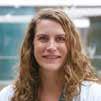
UK
Professor of Early Modern Literature and Culture at the University of Oxford, Nandini Das (1999) was awarded the 2023 British Academy Book Prize for Global and Cultural Understanding for Courting India: England, Mughal India and the Origins of Empire, Bloomsbury Publishing, 2023.

USA (Massachusetts)

Professor Douglas Melton (1977), Co-Director of the Harvard Stem Cell Institute, Howard Hughes Institute of Medicine Investigator, and Distinguished Research Fellow at Vertex Pharmaceuticals, was awarded the ABARCA Prize 2023 for his breakthrough work towards a cure for diabetes type 1. He is also the winner of the 2023 Manpei Suzuki Prize for Diabetes Research.
Cyprus
Writer Alex Michaelides (1996) was named as Cyprus’ Man of the Year 2023 at a ceremony in Nicosia in December. The award was presented by President of Cyprus, Nikos Christodoulides. Alex’s third novel, The Fury, is out now from Michael Joseph.

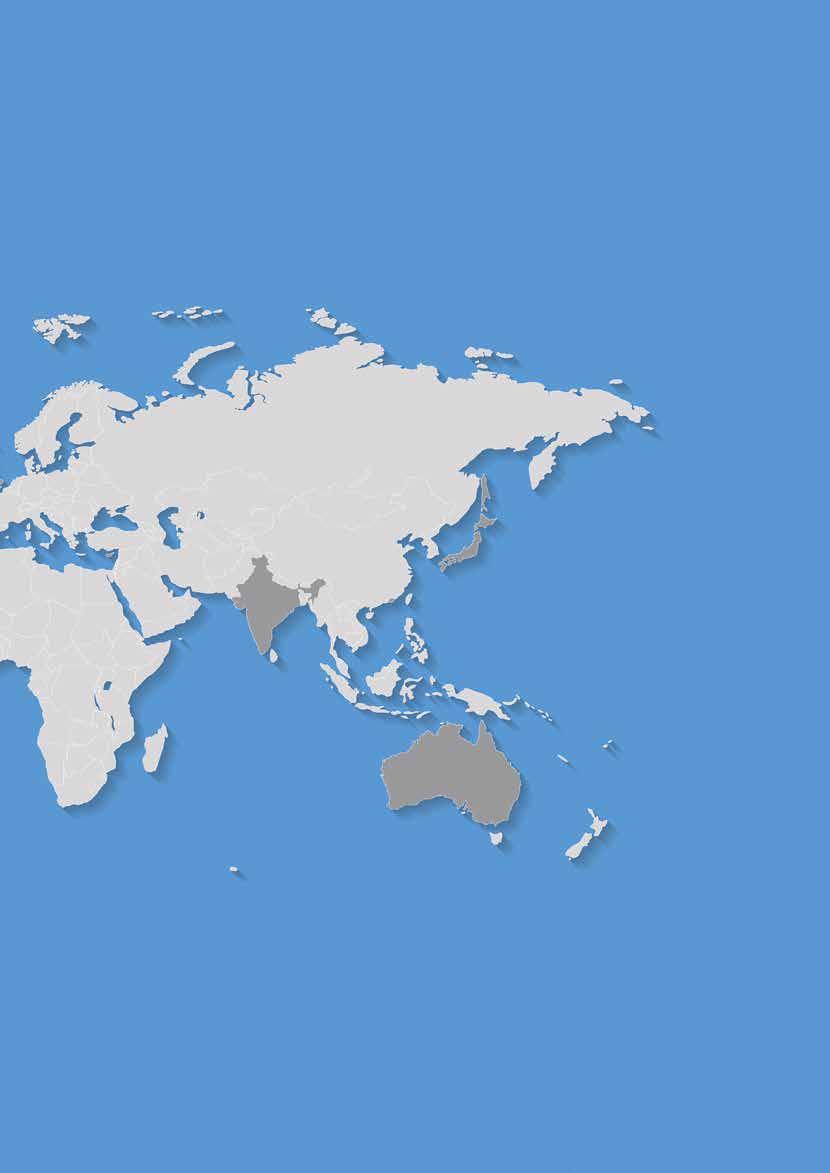

Historian and art historian, podcaster and Jaipur Literature Festival co-director, William Dalrymple (1984) was awarded a CBE for services to Literature and the Arts in the King’s Birthday Honours, June 2023. William is a Visiting Fellow at All Souls College, Oxford for Trinity Term 2024, and his next book, The Golden Road: How Ancient India Transformed the World, is out from Bloomsbury Publishing on 12 September.
Japan (Tokyo)
Trinity in Japan turns 10 this year and is celebrating the anniversary with a special event in Tokyo on Friday 6 September. All Members are welcome, and details will follow soon. Please keep an eye on the website: www.trinityjapan.org

Australia (Sydney)
Emeritus Professor Roy Green (1976), former Dean of the UTS Business School at the University of Technology Sydney and currently Special Innovation Adviser to the Vice-Chancellor, has been made a Member of the Order of Australia (AM) for “significant service to business, and to tertiary education in the fields of science, technology and innovation.”
The first Trinity Regional Gathering for alumni in East and Southeast Asia was held in Hong Kong on 12–14 January. The Master, Dame Sally Davies, Senior Bursar Richard Turnill, and Fellow and astrophysicist Professor Didier Queloz joined alumni for a weekend of talks, visits, and a Gala Dinner. It would not have been possible without the generosity of many people. In particular, thanks to Tzo Tze Ang (1997) and Eashwar Krishnan (1996), Selena Sun (1995) and Patrick Tsang, Brian Davidson (1982), and Yang Xia (2003) for their support.
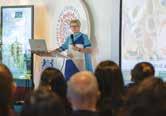
On 23–24 February, more than 2500 people online and in person watched Trinity’s Byrothon, the 24hour reading of alumnus Lord Byron’s works, which launched the College’s bicentenary commemoration of the poet’s death. The event in which 80-plus students, staff, Fellows, and alumni read aloud 185,000 words from Byron’s poems and letters in the College’s Antechapel attracted wide media coverage.
Among the alumni reading were writer Freya Berry (2010), theatre director Atri Banerjee (2011), the current Lord Byron (1969), and actor Pip Torrens (1978), who kicked off the Byrothon with She Walks in Beauty and who said: “He’s absolutely amazing … what strikes you is the unbelievable facility he has for verse in its many forms.” Lord Byron said the Byrothon was “a brilliant idea” which he would not have missed. Asked what it was like being Lord Byron, he said: “There are plenty of Lords around, but if you’re going to have a title, I think Byron is a pretty good one to have.”
Emeritus Fellow in English Literature Professor Adrian Poole (1967) who directed the Byrothon was delighted by the response: “It was a resounding success – if I say so myself, but also on behalf of everyone who took part, whether as readers, the audience in person and online, or as organisers. In over 50 years at Trinity now I don’t think I’ve ever experienced such an extraordinary collaboration.”

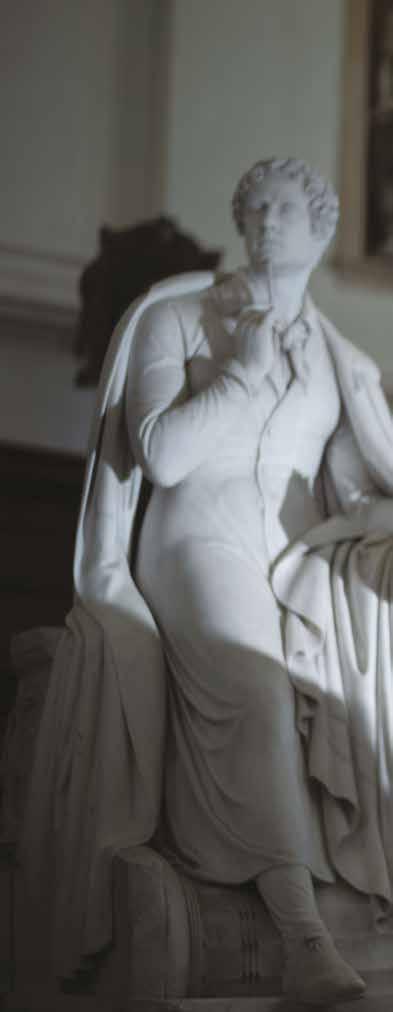
Lord Byron died on 19 April 1824 and the College marked 200 years since his death with the Byron Festival at Trinity. Activities included a conference, a special event in the Wren Library with representatives from the Greek government and Greek community laying a wreath at Byron’s statue in his honour, and a recital for which Honorary Fellow of Trinity and Master of the King’s Music, Dame Judith Weir composed new work in response to Byron’s poem Bright be the Place of thy Soul! performed by Florian Störtz (baritone) and Malcolm Martineau (piano).
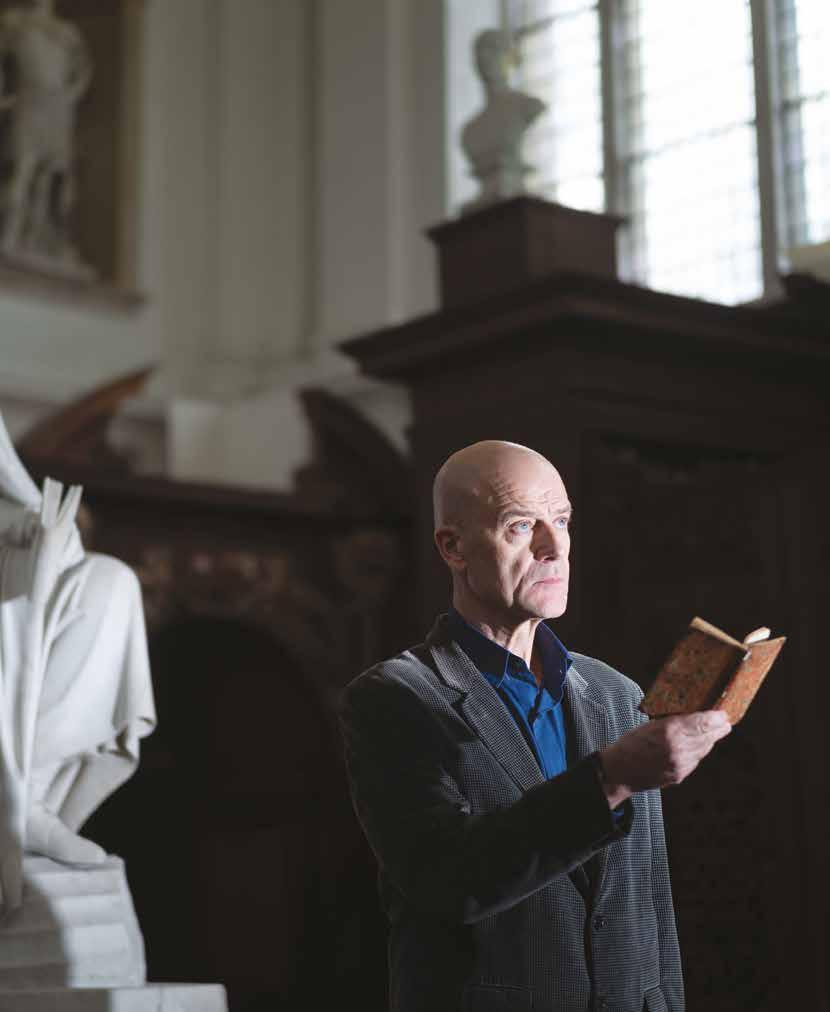
Other events included readings in the Antechapel of new poems, created in response to Byron, composed by poets including Mona Arshi (e2022), Adam Crothers, Parwana Fayyaz (2016), Mina Gorji (1993), Peter Graham, Gregory Leadbetter (1993), Angela Leighton (e2006), Stav Poleg, Michael Symmons Roberts, AE Stallings, and Rebecca Watts (2001). The three Cambridge student winners of the Byron Now poetry prize – Benedick McDougall, Georgina McNamara and Kendra Nydam – also read their compositions.
These new writings were funded by a generous donation from alumnus, David Manns (1964), along with specially commissioned drawings of scenes from Don Juan by research Fellow, Dan Sperrin (e2021), on display in the Wren Library, and publication of a collection of essays, Byron and Trinity: Memorials, Marbles and Ruins.

The Wren Library curated ‘Exhibiting Byron’, a special display of original manuscripts, letters and first editions of works by Byron and his circle. The exhibition will remain open (during public opening hours) until the end of June.
Read more: trin.cam.ac.uk/news/the-byron-festival-attrinity/ trin.cam.ac.uk/news/1823-letter-discoveredin-trinitys-wren-library-describes-byrons-lostmemoirs/ trin.cam.ac.uk/news/inspired-by-don-juan -dr-dan-sperrins-drawings-on-display/ openbookpublishers.com/books/10.11647/ obp.0399
Following last year’s success, Trinity’s Languages, Power, and Cultures programme returned this year to support 16–17 year olds from underrepresented backgrounds to explore the option of studying at Cambridge. The three-month initiative features online interactive lectures, a residential visit to Trinity with travel and food expenses included, an essay competition, and a careers panel with alumni. Thank you to webinar panellists Sonum Sumaria (2008) and Ellie Tobin (2014) who shared their invaluable advice and experience with the group, and to Michael Squire (1998), who sent a video for participants to watch.
More than 70% of the Year 12 students who participated in the programme in 2023 and applied to Cambridge received offers, for subjects including History, Classics, English, and Anglo-Saxon, Norse and Celtic. The initiative was designed by the College’s Access and Outreach team to engage prospective students with what it would mean to study languages. Trinity Outreach Coordinator, Amber Silk said:


“To learn more about Trinity’s Access and Outreach programmes and how you can get involved, please visit the website: trin.cam.ac.uk/access/ outreach-home/outreach-programmes/
This is a great outcome and we’re really proud of the programme. We know that students with fewer specialist language teachers in their school face increased barriers when considering further language study, so we wanted to provide an experience of real university learning.
After this year’s residential on 4–5 April, students were asked about their experience of the visit to Trinity and its impact on their plans for the future. Participant feedback was again positive and included the following comments:



Thank you for giving me the opportunity to go to Trinity College for the residential last week. It was an absolutely incredible experience and I gained very valuable insight into what studying at Cambridge would involve.







This has inspired me immensely and helped me more than you can imagine; thank you so, so, so much!!







It was an experience to remember! I got immersed into the world of Trinity College straight away and felt the true university experience – which I loved!




Trinity has returned four spears to representatives of the La Perouse Aboriginal Community, including direct descendants of the Gweagal people who crafted them more than 250 years ago.
At a ceremony in the Wren Library on Tuesday 23 April, the Master, Dame Sally Davies, welcomed more than 100 guests, including the Australian High Commissioner to the UK, Stephen Smith, representatives from museums in the UK and Australia, and members of the indigenous community, Trinity College and the press.
Members of the La Perouse Aboriginal Community and Dharawal nation performed a traditional ceremony prior to speeches and the signing of the document confirming the permanent repatriation of the Gweagal spears to Kamay (Botany Bay) near Sydney, where they will be housed in a new museum.
Noeleen Timbery of La Perouse Local Aboriginal Land Council said of the spears: “They are an important connection to our past, our traditions, and cultural practices, and to our ancestors. Our Elders have worked for many years to see their ownership transferred to the traditional owners of Botany Bay. Many of the families within the La Perouse Aboriginal Community are descended from those who were present during the eight days the Endeavour was anchored in Kamay in 1770.”

The Master said of the occasion: “This is an important day at Trinity for all parties involved in what has been a rewarding and respectful process, and ultimately a remarkable journey. We are delighted to be able to return the Gweagal spears to the La Perouse Aboriginal Community. We would like to thank all those who have taken part in good faith in the discussions and exchanges that have enabled us to reach this point. This is the right decision and Trinity is committed to reviewing the complex legacies of the British empire, not least in our collections.”
Read more:
trin.cam.ac.uk/news/these-spears-connect-usculturally-spiritually-and-tangibly-toour-ancestors/

2024 is the centenary of the death of Sir Charles Villiers Stanford (1852–1924). While still an undergraduate at Cambridge, Stanford was appointed Director of Music at Trinity, a post he held from 1874–1892.
In 1882, aged 29, he was also one of the founding professors of the Royal College of Music, where he taught composition for the rest of his life. Among the best known of his many pupils are Samuel ColeridgeTaylor, Gustav Holst, Ralph Vaughan Williams, John Ireland, Herbert Howells, Rebecca Clarke, Frank Bridge and Arthur Bliss. Although now primarily known for his choral music, Stanford composed a number of orchestral works, including seven symphonies, operas, and chamber music. He also orchestrated some of his canticles written for services.
On 16–17 March, the College held a weekend of music to celebrate his life, his contribution to Trinity and Cambridge, and his lasting influence on the music of the last century. The festival opened on the Saturday with an orchestral evensong which saw the College Choir joined by former members of the Choir and Britten Sinfonia. The music for the service included Stanford’s wonderfully rich orchestration of his Magnificat and Nunc Dimittis in A, together with the Te Deum in B flat.
The Sunday celebrations began with a lunchtime chamber music recital featuring Stanford’s Clarinet Sonata in F major, Op 129 (Clarinet – Samuel Huston, Piano – Antonio Morabito), and his Violin Sonata No 2 in A major, Op 70 (Violin – Leora Cohen, Piano –Paul Wingfield). The festival concluded with a recital by the Choir of Stanford’s choral music including wellknown favourites, together with a number of pieces which were new to the Choir’s repertoire.
The Choir also released eight new videos on their YouTube channel to mark the centenary, including a wonderful mini documentary ‘Stanford at Trinity’ presented by alumnus Jeremy Dibble (1977), Emeritus Professor of Music at Durham University.

Do watch the videos and enjoy Stanford’s music: youtube.com/TrinityCollegeChoir
Caricature of Stanford by Spy, Vanity Fair, 1905.

The 2024 Trinity Bradfield Prize winners were announced at a ceremony held on 21 January at the Bradfield Centre on the Cambridge Science Park. Now in its fifth year, the competition offers a total prize of £20,000 for three winners, a mentoring programme, and free membership of the Bradfield Centre, where a community of 700 innovators and entrepreneurs are based.
Cambridge Nucleomics scooped the overall prize for their fully automated point-of-care sepsis test with results in under an hour. Compound Hound won second place for their breath sensor to detect if a newborn baby is suffering from jaundice, and BioTryp Therapeutics took the Hellings Prize for a new class of biofilm inhibitors, providing an alternative to traditional antibiotic treatments.
Former Master of Trinity and biotech entrepreneur Sir Gregory Winter (1970) who announced the winners said: ‘The quality of the business proposals and their presentation have gone from strength to strength over the years, and this almost certainly reflects

the mentoring provided to contestants before the event. Most of the proposals had at least one compelling feature, and it was challenging to determine the winners.
In the end, the judges prioritised those that seemed closest to commercialisation. Next year we hope to offer another prize for those from this year’s shortlist who make the most progress during the year. So, we will see whether the judges were right – all judges must be willing to be judged!’



My first session with my mentor was amazing. He offered a lot of insight into preparing for interviews and advice on my career plans. I really enjoyed talking with him and I will start working on the books he recommended.
(Brian C., 2023, Engineering)







Mentoring will be very rewarding to both you and your mentee. You will find so many ideas and experiences from your past at Trinity as well as your career that your mentee will find invaluable.
(Kimberly S., 1989, Physics)


Mentoring Month aims to help our students manage the end of their academic studies and to prepare for the beginning of their professional journeys.
Thanks to a fantastic response from students and alumni, the second year of Mentoring Month produced almost three times as many mentor-mentee relationships as the first year (2023 – 28; 2024 – 75), with insights, guidance and support provided to current Trinity students across a terrific variety of careers and industries.
As the world of work becomes increasingly varied and often difficult to navigate, both alumni and students found this exchange of knowledge and the opportunity to network both enriching and rewarding.
We are hugely grateful for the support of all who participated.

If you would like to learn more about Mentoring Month, read about the experiences of some of our student mentees and alumni mentors, or find out how to take part in further mentoring projects, please visit trin.cam.ac.uk/alumni/community/mentoring/
By Vice-Master Professor Louise Merrett (e2003)

In 2046 Trinity will celebrate a major milestone – the 500th Anniversary of its founding. Looking forward to such an important moment in its history, last year the College commissioned architects Allies & Morrison to produce an estate plan, providing a comprehensive and innovative vision for how Trinity’s buildings and green spaces could be developed over the next 30 years and beyond.
Trinity needs to continue to offer the best possible education and experience if it is to maintain its position and compete with other leading colleges and universities around the world in attracting the best students, staff, and Fellows. Providing a welcoming, accessible, and inspiring environment with modern and appealing facilities is key in ensuring that the College continues to remain at the forefront of


education and research and can meet the needs and expectations of future generations.
I have been leading the College’s planning committee for the project in collaboration with the architects. After a year-long process of comprehensive engagement with students, staff, Fellows, and alumni via a series of surveys, consultations, exhibitions and workshops, the plan was finalised and presented to the College in February 2024.
The process has encouraged me to appreciate anew Trinity’s beautiful and varied spaces. The buildings and grounds stretch over a continuous 47 acres, from the centre of town in the east towards the new development in west Cambridge, with elements which have been added or improved over the past 500 years to create the diverse estate we enjoy today. Hearing the results of the extensive consultation highlighted that we must continue to innovate and provide buildings and spaces of the highest quality. This will ensure that future generations will benefit from living and working in Trinity and will enjoy the cross-generational and interdisciplinary exchange of ideas and knowledge which distinguishes collegiate Cambridge. It is also clear that sustainability must be at the heart of everything we do.
There are a wide range of estate development opportunities included in the Trinity 2046 plan. There will be three major projects that will address the most pressing needs identified in the consultation and be transformational for the College:
The challenge
Trinity’s Wren Library is one of the world’s great libraries. Its architect anticipated the expansion of its collections and designed the building to ensure it would be able to cope with increased demand. However, the College Library for students has almost reached storage capacity and lacks specialist spaces. This affects the College’s ability to look after its existing collections, to receive new material, and to preserve its own history effectively.
In addition, desk space is already in very high demand and the Library is in urgent need of more highquality study space. It must support a large student

An elevated gallery in the Library would increase desk capacity, add light, and offer views over green spaces.
community while providing a comfortable, flexible, and inspiring environment for study and research.
The solution
In order to meet this challenge, our architects propose clever reconfiguration and expansion of existing library space to deliver an additional 80–100 study spaces and a generous new reading room. This can be achieved by:
• Relocating parts of the collections.
• Redesigning and maximising the existing space.
• Extending the basement.
Reconfiguration and expansion of existing Library space would allow a variety of areas for different study modes, from individual to larger group seating.



The challenge
Study and social facilities with the capacity to welcome all members of the College are currently limited. The Bar is incredibly popular, both as a place to study and to socialise, but it is too small for the size of the community and lacks access to outside space. The ways in which people work and study are changing too, with increased demand for informal working space in a more social setting.
The solution
To provide a larger community facility, the Brewhouse site, situated on the river, could be developed to offer a welcoming and inclusive study and social space in an inspirational setting. With access to an outdoor terrace directly overlooking the river and the ability to open out onto Brewhouse Lawn, it could offer an unparalleled new facility for the College. The redevelopment would be a green, net zero carbon building, with a low embodied carbon all-timber structure, fossil fuel-free heating, and passivhaus levels of energy efficiency and comfort. It could offer:
• One large accessible community hub, centred around a new café.
• A diversity of different spaces for socialising, studying, meeting, and working.
• Flexibility for larger events for 200–300 people, such as Annual Gatherings and whole student year groups, or multiple spaces for smaller meetings and workshops.


The challenge
Discussions with members of the College identified the need for modern and welcoming environments for sports and wellbeing programmes. Although Old Field’s outdoor pitches are high quality, the space could be better used, and the indoor spaces need improving to offer modern facilities with greater capacity and flexibility.
The solution
• Creating a new multi-use games area and practice pitch for outdoor sports, alongside the rugby, football, cricket, tennis, and netball pitches.
• A new indoor sports centre could provide a large multi-use court, squash courts, gym rooms, yoga and pilates studios and changing rooms, enabling the College to extend its sporting activities and enhance its wellbeing offerings.
• A new café could also provide an additional flexible social space for workshops and other events and activities held at the site, strengthening the community.
I hope that this preview of three key components of the Trinity 2046 plan will inspire you. We will continue to share updates on the latest developments in our alumni communications. It is exciting to be working together on such an important project and we are tremendously grateful to everyone who has shared their thoughts with us. Your ideas and support will help to ensure that Trinity is in excellent health as it celebrates its quincentenary, and that the College is in the best possible position to meet the challenges of its next 500 years.
If you would like information on supporting the Library, Brewhouse, or Old Field projects, or you want to learn more about other Trinity 2046 opportunities, please contact us at alumni@trin.cam.ac.uk
(2021, History)
Meet Jacob, who’s at home in the spotlight.
I am a third year historian at Trinity, currently focusing on the history of political thought. I’ve always found History to be a very diverse discipline, and studying at Trinity has not disappointed in terms of giving me the opportunity to explore some of my favourite topics with a variety of approaches.
My Cambridge experience has been largely characterised by my creative pursuits, particularly in the worlds of music and theatre. Throughout my journey so far there have been some notable highlights, the first of which was playing the leading role in the European Theatre Group’s tour of Hamlet (2022). We toured in Belgium, Germany, Switzerland, and London; it was a privilege to perform for so many audiences, and to see so many wonderful places for the first time. It was an unforgettable experience and I’m grateful to have been alongside an incredibly talented group of people.


More recently, I had the opportunity to play Mercutio in Romeo and Juliet. This was 2024’s Marlowe Arts Show, an annual event where a professional director is brought in to direct a Shakespeare play at the Cambridge Arts Theatre. This year’s director was Josh Seymour, who had previously worked on such plays as The Normal Heart (National Theatre) and A Christmas Carol (Old Vic). This experience was quite different to any other I have had in amateur theatre. Josh’s knowledge and method was invaluable and insightful in helping me develop my own reading of Mercutio, and this is the performance which I am perhaps most proud of.
I also act in contemporary plays, including student writing which I have performed at the Edinburgh Fringe Festival. At Fringe 2022, I performed in both Life Before the Line by Amy Lever and Heroes by Chakira Alin (Marlowe Other Prize and Mustapha Matura Prize winner). In 2023, I performed in a musical called Palindrome by Neve Kennedy and Jas Ratchford. Maddy Power (also at Trinity, 2021) wrote the book for
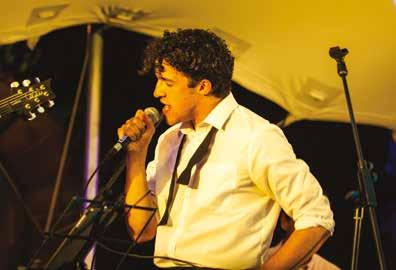

it, and the musical was produced by Trinity alumna Aoife Pallister Begadon (2020). There are many opportunities in Cambridge, and creativity here is not only prevalent but celebrated – I am very excited by the movements the College has recently been making in promoting the arts.
I also sing in a few bands in Cambridge, most frequently Churchill Jazz and a function band called Hot Content. I have been the singer for Churchill Jazz since matriculating in 2021, and it is a blast getting to perform some of my favourite songs by the likes of Dean Martin, Frank Sinatra, and Ray Charles to audiences at events across Cambridge including the Trinity May Ball! I was a founding member of Hot Content in 2022 and we quickly became one of Cambridge’s premier pop and funk bands, performing at a range of student events, from club nights to charity fundraisers to May Balls. In the 2022–23 academic year I performed around 50 gigs, including almost 20 in May Week alone! This was
both exhausting and exhilarating, but I hope to repeat something similar to this feat in May Week 2024.
I have also sought to leverage my creativity for positive social change. In February 2023, I co-founded a Cambridge based charity called ‘Beyond Borders’, which aims to raise money for disaster victims across the world. The work we do predominantly involves ticketed events with live music; since starting up we have raised in the region of £5,000 for disaster victims in Turkey, Syria, Morocco, and Gaza. I hope ‘Beyond Borders’ continues after I leave Cambridge.
In the future, I hope to continue with both music and theatre, though I have a particular eye on developing my craft as an actor. It has been a longstanding dream of mine to become an actor; I am inspired by brilliant work in theatre and on film, and this is a feeling that I hope to instil in others. Trinity College has an impressive list of alumni in the arts, and it is one that I hope to add my name to one day.
Three Trinity musicians share what sparked their passions, discuss their memorable moments and creative achievements, and preview forthcoming projects.
Charlston (2011, Music),
mezzo-soprano
Q What sparked your interest in music? Was there a person or piece of music that inspired you? I have sung for as long as I can remember. I was fortunate to grow up in a household full of music –my father is also a professional musician, so I was used to spending time at concerts or listening to him rehearsing. I was also very fortunate to be born in the right decade that meant, despite my gender, I could be a chorister at my local cathedral: St Albans. I was a chorister from the age of seven to fourteen, and it was here that I became sure that singing needed to be something that remained in my life forever.
Q What was the best thing about studying Music at Cambridge and the most memorable moment? It was a very exciting and creative cohort. The extreme variety of interests of people on my degree and around the University making music is one of the special things about Cambridge. There is space to try anything you want, and to make music to an extraordinarily high standard. Singing in the Trinity Choir was a huge part of that for me – expectations were high and the music we made together has stayed with me for a long time. I still work with many people that I studied with, and I am continually inspired by their creativity and development.
Q Describe your path since leaving Trinity. After graduating in 2014, I worked in the Trinity Chapel and Music Office for a year, which was a wonderful opportunity to bridge the gap between my degree and working out what steps to take to get into the music profession. I did lots of auditions, for as many opportunities as I could find, and began to build up a network. My first big solo performance came that year, singing Bach’s Matthew Passion with the Gabrieli Consort conducted by Paul McCreesh at the Aix Easter Festival.
I won the London Handel Competition in 2018, the song prize in the 2021 Kathleen Ferrier Competition
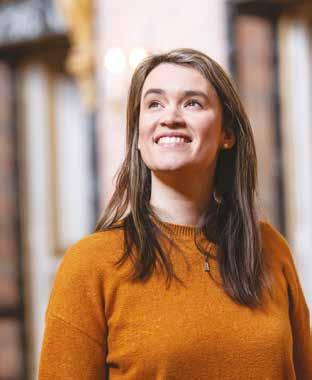
and was a laureate of Jardin des Voix in 2021–2022, a young artists’ programme with Les Arts Florissants, and was a BBC New Generation Artist (2021–2023). Concerts have taken me to Australia, New Zealand, USA, Canada, Japan, and South Korea; I made my debut at the BBC Proms last year; sang the title role in Dido and Aeneas at the Royal Opera in Versailles; and the Sorceress in the same opera at The Grange Festival. I’ve just been working at the Opera National de Paris, covering the title role in Charpentier’s Médée
Every week and month is different to the last, but the common thread is wonderful music, often in very beautiful places, so I count myself really lucky!
Q What’s the piece of work or performance you’re most proud of and why?
I recently won both a Gramophone Award and BBC Music Magazine Vocal Award for my solo album, Battle Cry: She Speaks. It’s a programme centred around


17th century music – particularly by Barbara Strozzi and Henry Purcell – that I absolutely love to perform with my duo partner, lutenist Toby Carr. Alongside this old music, we commissioned Owain Park (Trinity, 2013) to write a new set of songs for this pairing. It was a relatively unusual project, as this combination of voice and lute doesn’t often have new music written for it. Owain set new lyrics by Georgia Way (also a Trinitarian, 2011!) to music, so for me it was a very special project, working with people I had met as a student and seen grow over the years.
This was the first project I put together for myself from scratch, and I am really proud of all we achieved. It says a lot about who I am as a musician, and I’m so glad people have loved it as much as I do.
Q What forthcoming projects are you excited about? Next summer I will make a house and role debut at the Gran Teatre del Liceu in Barcelona singing Sesto in Handel’s Giuilio Cesare, directed by Calixto Bieito, conducted by William Christie. I’m also recording my next solo album soon and can’t wait for that to find its way into the world in 2025.
Q If you could collaborate with any artist past or present, who would it be and why?
I wish I could have been a fly on the wall for rehearsals and pretty much every performance of Peter Sellars’
production of Handel’s Theodora with Lorraine Hunt Lieberson singing Irene at Glyndebourne in 1996. She was an extraordinary artist, completely whole and genuine in every performance. I’ve watched her on video, listened to audio recordings and learnt so much from her singing, but I am so sad I never met or heard her live before her untimely death in 2006.
Q What’s the biggest challenge facing young musicians looking to enter the industry, and what advice would you give to those aspiring to follow in your footsteps?
Trust your instincts, musical and otherwise. We spend so much time learning technique, which is vital to give us the freedom to fly as musicians, but it must be paired with trusting yourself and your response to the music. You have something to say as a performer so trust that you know how to say it. Also, nothing is off bounds: listen to, watch, and absorb all music that you can. You never know what may spark your next project.
helencharlston.com delphianrecords.com/products/ battle-cry-she-speaks @helencharlston @helencharlston
Q What sparked your interest in music? Was there a person or piece of music that inspired you?
My father’s family were immigrants from Russia and Lithuania. They left their homes behind but kept their love of books and music. As a child I would sightread for hours at the piano – the collected works of great composers – and learnt to play guitar by ear and write folk songs. I would fall asleep listening to Keith Jarrett’s Köln Concert, Rubinstein’s recordings of Chopin’s Nocturnes, Schiff’s recordings of Bach and Maria Callas singing Verdi or Puccini. It was a childhood filled with music.
Q What was the best thing about studying at Cambridge and the music scene, and the most memorable moment?
When I wasn’t reading (or writing my own stories) I was giving concerts with other musicians. There are endless opportunities at Cambridge to perform with superb instrumentalists and singers. Trinity gave me a grant to translate a play I had written into Russian and take it to Moscow and St. Petersburg. A memorable moment was doing a read-through at the Maly Theatre, Moscow, when its artistic director pointed out
I was sitting on a chaise longue that was a favourite of Joseph Goebbels – taken from his Berlin office by the Russian army in 1945!
Q Describe your path since leaving Trinity. I studied piano performance at the Royal Academy of Music in London. I wanted the conservatoire experience and to take my playing to a professional standard. Whilst I enjoyed live performance at venues such as Wigmore Hall, I found I was happiest in the recording studio. Alongside music, I worked as a freelance writer and wrote screenplays for film and producers, progressing from speculative to commissioned scripts. I also completed my first novel, securing a two-book deal with a publisher.
Q What’s the piece of work or performance you’re most proud of and why?

My first album Homelands for the Rubicon Classics label. It was with the magnificent tenor Ian Bostridge and a great ensemble of singers. We performed live on BBC Radio

dp/1782279180
3 and went into the UK Classical Charts Top 10. A concert of the album with actor Simon Russell Beale raised large sums to help schoolgirls who had been displaced by the war in Afghanistan. Recording with Ian was a huge privilege and I love that in addition to making a beautiful album, our music had a humanitarian impact.
Q What forthcoming projects are you excited about?
My debut novel, Murder in Constantinople, a murder mystery which will be published by Pushkin Press in autumn 2024. The release of my second album, with soprano Cecilia Rangwanasha, which we recorded at Abbey Road Studios. And the final polish of my current screenplay, an action-adventure for a studio –a first foray into bigger budget movies.
Q If you could collaborate with any artist past or present, who would it be and why?
Sam Mendes. I admire the breadth and variety of his work in film and theatre. The Lehman Trilogy, for example, was an ingenious piece of stagecraft, whilst 1917 was a virtuosic piece of filmmaking. He brings an auteur’s taste to projects that have commercial appeal – a combination that I seek to emulate in my work as a writer. In that respect he is a major source of creative inspiration.
Q What sparked your interest in music? Was there a person or piece of music that inspired you?
I grew up in a very musical household – my mum is a piano player, teacher, and accompanist – so I don’t have a memory of my first experience with music as it was always around! She started teaching me the basics on piano when I was around five years old. When I was eight years old, I was rummaging around in the cupboards at home, looking for a new toy to play with, and stumbled across my dad’s old trumpet. He had played in school, but not since, so it was just gathering dust. I was instantly attracted to the shiny instrument and could make a decent sound on it – so that’s where the story starts!
Q What was the best thing about studying Music at Cambridge and the most memorable moment?
My favourite thing was discovering and learning about styles of music that were completely new to me. As an instrumentalist, I already knew a lot of symphonic orchestral repertoire, but I fell in love with early vocal
Q What’s the biggest challenge facing young writers and musicians, and what advice would you give to those aspiring to follow in your footsteps? There will always be setbacks as you start your career and it is very important not to allow yourself to be daunted by them. Key to success is being resourceful and tenacious in finding solutions to whatever problems arise on the journey. The most essential part of this is having belief in yourself and in the value and integrity of the work you are creating.

music and its development from Gregorian Chant up to four-part polyphony. I took as many papers as I could on this subject, spending hours learning how to read ancient music in beautiful old codices and transcribing them into modern day notation. My memorable moment was the 24-hour fugue paper we undertook in our first year; I was awake almost all night, fuelled by an assortment of sweets, had a complete panic with the printer in the Trinity Library and had to run to the Music Faculty in the rain, in my pyjamas and flipflops, to get it in on time!
Q Describe your path since leaving Trinity.
I moved to London to study at the Royal Academy of Music. I focused on my goal of becoming a trumpet soloist: entering competitions, performing as many solo concerts as possible, learning new repertoire and studying with top soloists around Europe. One of these was Håkan Hardenberger, who became my mentor and professor in Malmö, Sweden after I had finished at the Academy. During these years, I recorded my debut album with piano, Direct Message, and participated in many Young Artist schemes, which helped me secure management with Hazard Chase (based in Cambridge).
Unfortunately, when Covid hit in 2020, I was faced with no concerts, multiple lockdowns, and the dissolution of Hazard Chase. I was very uncertain about my future in the world of classical music, and for a couple of months I had a complete identity and confidence crisis. I finally decided that I would recommit myself 100% to becoming a trumpet soloist, quitting my parttime marketing job, and setting myself targets over the next 18 months to help me get back on track. These included finding new management and recording my opera arias album Casta Diva with an orchestra. We are now three years down the line and I’m ecstatic that these projects have come into fruition and I’m still here!
Q What’s the piece of work or performance you’re most proud of and why?
My recording of the Weinberg Trumpet Concerto, which will be released on Chandos Records this November. It was an incredible experience to record this behemoth of a work with the London Symphony Orchestra and Lee Reynolds at the end of last year and I can’t wait for everyone to hear it!
Q What forthcoming projects are you excited about? I couldn’t be more excited about the first trumpet concerto written for me! Robin Haigh has written an exhilarating tour-de-force called LUCK, and I will perform the world premiere at the Aldeburgh Festival

on 15 June with the Britten Sinfonia and Jessica Cottis. It will also be recorded for broadcast on Radio 3; you won’t have heard anything written for trumpet quite like this before.
Q If you could collaborate with any artist past or present, who would it be and why?
Conductor Gianandrea Noseda. As a member of the European Union Youth Orchestra during my years at Trinity, I spent two summers touring with him performing some incredible repertoire (including Mahler’s 5th Symphony) and would love to work with him again, but now on one of my favourite concertos.
Q What’s the biggest challenge facing young musicians looking to enter the industry, and what advice would you give to those aspiring to follow in your footsteps?
How much time have you got? There are so many challenges, not least all the funding cuts, but I think it’s important to remain positive and committed. My advice would be to work out exactly what kind of career you’d like to have and look at the steps you need to get there. Also, ask people for help! Find people that are further along that path than you and ask them for advice and input. I used to be so afraid to reach out to those I admired, but I’ve learnt that they are often flattered to be asked and usually delighted to give advice.

By Nicolas Bell (e2015), Librarian

The book depicted by Hans Holbein the Younger in his portrait of Thomas Cromwell, Chief Minister to King Henry VIII, was identified in 2023 as a specially bound Book of Hours held in the Wren Library at Trinity. Printed in Paris by Germain Hardouyn in 1527 or 28, this book was presented to Trinity in 1660 by Anne Sadleir, who was married to the grandson of Cromwell’s secretary, Ralph Sadleir.
The Holbein portrait dates from 1532–33 and is thought to commemorate Cromwell’s appointment as Master of the Royal Jewel House. It seems likely that the book was positioned so prominently in the painting because of its grand binding with jewels mounted in silver gilt. The identification was made following a request to loan this book to an exhibition at Hever Castle, the home of the Boleyn family. The castle possesses a copy of the same edition of this book which was owned by Anne Boleyn, and a third copy of this edition, now in the Morgan Library & Museum in New York, was owned by Catherine of Aragon. Both of these other copies have been rebound at a later date, so it is impossible to be sure of their outward appearance in the sixteenth century, but it is notable that three copies of the same edition had such prominent owners.
The discovery was first noticed by Hever Castle’s curator, Alison Palmer. Further research at Hever by Kate McCaffrey and Dr Owen Emmerson has shown that the silver borders are the work of Pierre Mangot, goldsmith to King Francis I of France. The binding
consists of wooden boards covered with black or dark blue velvet and surmounted with silver gilt borders which are fixed to each board with a single nail. Hallmarks on the silver borders prove that the binding was manufactured in 1530. The book does not include a precise date of printing, but the prefatory material includes a list of the dates of Easter for the following 14 years, which starts with the date of Easter in 1528.
This suggests that the book was probably printed between Easter 1527 and Easter 1528. It was then illuminated by hand in Hardouyn’s workshop, before being bound in 1530 and shipped to England sometime before 1532–33, when the portrait was painted. It seems likely that Thomas Cromwell gave this book to his secretary Ralph Sadleir, along with the Holbein portrait. Sadleir’s son Thomas was named after Cromwell, who had been his godfather, and Thomas Sadleir’s own son, Ralph, was the second husband of Anne Sadleir, who gave the book to Trinity College, where her father, the famous lawyer Sir Edward Coke, had studied.
Almanac showing the date of Easter in 1528 ([M]DXXVII) as 12 April.


“
The result of this analysis is conclusive evidence that the stones are in fact grossular garnets, another gem frequently used in ornamental metalwork of this period.
There was still a question to be answered about the jewels found on the binding and clasps. When Anne Sadleir presented the book on 10 August 1660, the jewels on the binding were described as jasper stones. This was corrected by a later writer to ‘hyacinthi’, or jacinths, but Pierre Mangot was well known for his use of another semi-precious stone, carnelian. Each of these stones has various symbolic meanings attributed to it in writings of the time, and it remained intriguing to establish the true identity of the stones. In order to prove with certainty what type of gemstones were used in the binding, we took the book to the NanoPhotonics Centre in the Cavendish Laboratory, where PhD student Joanna Symonowicz used Raman spectroscopy to analyse the chemical structure of the stones.
The result of this analysis is conclusive evidence that the stones are in fact grossular garnets, another gem frequently used in ornamental metalwork of this period and with a wide range of possible significance or meaning to its owners.
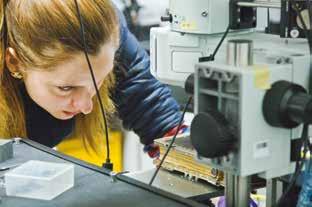
Despite this new identification, various questions remain unanswered. Why would Thomas Cromwell have chosen to be portrayed by Holbein with a private devotional book such as this? There are no annotations or other signs that Cromwell actually used the book in prayer, but it is rather extraordinary that, unlike in almost every other liturgical book in England, the calendar of saints in this book has not been amended by the removal of the feast of Thomas Becket, as was required by royal edict of Henry VIII in 1538.
There are intriguing links between the goldsmith Pierre Mangot and the Boleyn family, both of whom were living in Blois in the 1520s. It is even possible that Holbein may have collaborated with Mangot at some point, and not inconceivable that he may have been involved in the design of the book which he took such care to depict in the portrait. The strong likelihood that Anne Sadleir received this book from her husband also raises questions about the earlier history of the other book she gave to Trinity on the same day, the famous Trinity Apocalypse. Previous accounts of this book have presumed that she came into its possession through her eminent father, Sir Edward Coke, but perhaps a more likely route would trace this valuable manuscript from her husband directly to the court of Henry VIII through his trusted Master of the Jewel House, Thomas Cromwell.
Thomas Cromwell’s Book of Hours is fully digitised and can be viewed online via the Wren Digital Library: trin.cam.ac.uk/library/ wren-digital-library


By Dr Craig R. Walton (e2024) Trinity Junior Research Fellow in Earth Sciences
Planet Earth is home to all known life in the Universe. However, we still do not yet know why and how this came to be so. As the search for life beyond Earth continues, our home world continues to provide the best insights into where we should look and what we should expect to find.
The first life emerged on Earth over four billion years ago. This epic moment transformed Earth from a house into a home, with single-celled organisms racing one another to conquer the boiling lakes and dark oceans of our early Earth, surviving unimaginably destructive asteroid strikes, raging volcanoes, and acidic skies.
We might ask: where exactly did the origin of life take place? Was this environment the only possible point of origin, or simply the easiest place for life to get going? The answer here is absolutely crucial since it would inform where and how often we should expect to find life on other worlds. It is hard for us to approach the question of totally non-Earth-like life scientifically, and so our search is presently essentially for Earth-like life. The problem is: what does that even mean?

These questions are currently being discussed in reverent voices throughout the University of Cambridge. The most intense discussions take place in the form of the newly founded Leverhulme Centre for Life in the Universe. Truly, I have never been more excited than in attendance at one of their coffee seminar meetings, hearing about advances in the pursuit of knowledge about life in the Universe. These meetings are productive as well as wide-eyed with wonder. We are getting closer.
Nowadays, giant telescope eyes look to the sky –some wrapped in the vacuum of space, like the James Webb Space Telescope – and watch for spectral signs of life. Back home, geologists like me are joining the fray and adding our two cents to the topic of how life first started and what evidence of it on a distant planet might look like.
Frankly, geology is often not the first field that jumps to mind when people are asked about either the origin of life or finding extraterrestrial life, yet it is fundamental to both pursuits. Earth’s environments

– both those present today and those preserved in ancient rocks – tell us about the range of natural laboratories in which origin of life chemistry may have taken place. Moreover, the study of Earth’s history reveals to us what habitable planets look like in their youth, which is at least when the origin of life on Earth took place.
Finally, and perhaps most importantly, geology tells us in amazing detail how life and the planet have altered over time. Indeed, it is this interplay of biology and geology that ultimately produces signals – biosignatures – that we might remotely detect with telescopes. Without this understanding, we would not begin to know how to interpret data from an instrument like the James Webb Space Telescope.
Some examples. When Earth was born, it was a world devoid of oxygen. Much about those early days remains mysterious, but this is practically certain. Indeed, it seems that oxygen only approached modern levels somewhere around 500 million years ago, both due to increased oxygen production by life

and the decline of natural processes that destroyed oxygen, for example, volcanism. This anoxic Early Earth is a key data point. It tells us that 1) the origin of life took place without abundant molecular oxygen, and 2) if we are looking for Earth-like life on Earth-like planets, it is more likely than not that we would stumble across planets in their anoxic (90% of Earth history) rather than oxic (10% of Earth history) phase.
There are many other (more hotly debated) cases like that of oxygen, where the coupled changes in geology and life over time offer us insights into the origin of life as well as what to expect elsewhere. Whilst we have not yet reached consensus on many fronts – was early Earth hot or cold? Covered with land or oceans? – we are iterating towards ever more useful constraints on the problem. This is strongly reflected in the lab, where chemists are now making incredible discoveries on the basis of geological insight.
For example, it turns out that phosphorus – crucial for all known forms of life – is also exceptionally helpful for the prebiotic synthesis of DNA, cell wall precursors, and molecules needed for metabolism. Yet, phosphorus is only found in the necessary concentrations in a few environments, for instance, alkaline lakes. If we map over the conditions of alkaline lakes to the synthesis of DNA and so on, we find that things seem to fit rather nicely. Whilst the jury is still out, it may be that multiple
lines of evidence in time converge to show us almost exactly where life on Earth began.
I will conclude by pointing out some other incredible ways in which life reshaped our planet. For one, consider plants. They make up around 80% of all living matter on Earth. Ever since around 400 million years ago, forests have been the dominant ecosystems and environments on Earth, overtaking even the oceans. Next, coral reefs. The precipitation of mineral skeletons has led to a gigantic build-up of carbon-rich rock in the crust, completely reshaping how our climate is regulated. Finally, we have humans. Us! We are reconfiguring everything perhaps faster than ever before in Earth’s history. In time, we may become the most convincing and easy to spot biosignature of all time.
On that note, it is worth being humble in our quest. We have not yet seen any evidence of life beyond Earth. Either this is because Earth is incredibly rare – in which case we should take very good care of it – or because other worlds, and perhaps other intelligent species like us, sowed the seeds of their own demise.
As with everything else, our own unfolding history here on Earth will go some way towards informing us about the fate of our cosmic neighbours. Let us hope the answer is one that we like.
Dr Walton hails from Scotland. His scientific interests include early solar system processes, prebiotic chemistry, and the co-evolution of biochemistry with geochemistry. After completing a wide-ranging integrated Master’s degree at the University of St Andrews, he focused on the bioessential element phosphorus (P) during his PhD at Cambridge. His project examined phosphorus in meteorites, the origins of life, and Earth’s crust over time.
His current research seeks to determine just how different Earth-like planets might be from one another, and how we should go about searching for them, and is carried out in association with the Cambridge Institute of Astronomy and the Leverhulme Centre for Life in the Universe. In addition to his role at Trinity, he also holds a Research Fellowship at the Centre for the Origin and Prevalence of Life at ETH Zürich.
craigwaltongeosci.wordpress.com/ @lithologuy
Science fiction & fantasy author web page: amazon.com/author/crwalton-sci-fi
ACROSS
1 Like the young solver’s twentieth after vacation, getting flu badly (8)
9 Sat right behind this mate (6)
10 Steven’s opening ahead of family film (4)
11 Song by Schubert in ”Avenue Q” without question is by musical heroine (3,5)
13 One very small piece of poetry in the air (5)
14 Learned people enthralled by key astronomical treatise (8)
17 One read about renowned school (7)
18 The first month after fellow entertained upperclass libertine (3,4)
21 College fortunate to hold memory: one pictured with this Thomas (or Oliver)? (8)
23 Milestone as 2046 is, given Trinity’s capital (5)
25 Nice staircase that’s housing Clare’s drunk? On the contrary! (8)
27 Report of recent affairs involving all playing bridge together (4)
29 Bar in which Byron essentially leaves passage from a book? (6)
30 Stale French bread – not sandwiches, a big stick! (8)
DOWN
1 Place for prayers in volume that belongs to us, read aloud (4,2,5)
2 American University composer, music teacher, conductor and ex-Trinity organist (8)
3 2’s Magnificat: Evening Canticles played in this second-rate apartment (1,4)
4 King of Mercia starts to outline fortifications for Anglo-Saxons (4)
5 Offering wine during concert (6)
6 Place of learning – a French one (3)
8 Freedom to go climbing occupies non-professional (6)
12 We sanction a terribly well-known polymath (5,6)
15 Famous rock drummer’s cheeky display? (4)
16 Open to view Lord Byron’s most famous animal in broadcast (4)
19 Lacking experience, Empoli’s first team in Turin scoring no goals up front (8)
20 Criminal on bail in England when booked (6)
22 Dame Sally is one that’s content in Michaelmas Term (6)
24 Balls like a tiger scratched top and bottom (5)
26 Poor penniless social workers (4)
28 Guitar amps with variable energy (3)
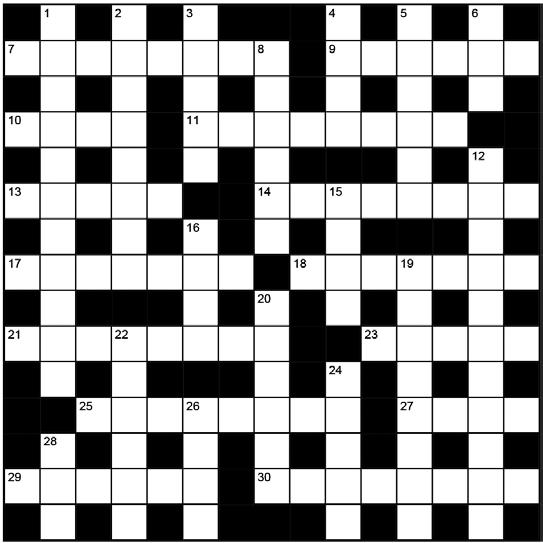
Please email your entry to alumni-comms@trin.cam. ac.uk or send it to us:
The Editor, Alumni Relations & Development Office Trinity College, Cambridge CB2 1TQ
Entries are due by 30 September 2024.
Visit The Fountain web page for a Word version of the crossword: trin.cam.ac.uk/ alumni/publications/the-fountain
The first correct entry drawn will win a copy of Trinity Poets, and the winner will be announced in the next issue of The Fountain
For the solution to Cryptic Crossword No.9 visit The Fountain web page listed above, or email us at alumnicomms@trin.cam.ac.uk
Alumni competition
Congratulations to Bethany Austin (2018) who successfully completed Trinity Cryptic Crossword No.9, winning a copy of Trinity Poets
Student competition
Congratulations to Kristina Kostadinova (2022) and Maggie Porter (2022), winners of the sixth student crossword competition in memory of avid crossword fan John Grenfell-Shaw (2011). The prize of a generous Trinity catering credit is kindly supported by John’s parents, Jenny and Mark.
Tim King (1980) is the Ipswich-based professional crossword compiler Encota. Tim also sets personalised puzzles as unique and thoughtful gifts. If you’d like to know more, contact him at: specialisedcrosswords@gmail.com and visit his website: www.specialisedcrosswords.co.uk
You can still be a part of it!
For last year’s fantastic first ever Giving Days, 479 donors worldwide came together and raised £342,000.
Giving Days were back again on 12–13 June, raising funds for Areas of Greatest Need, Student Support, Access and Outreach, and our new Student Experience, Health and Wellbeing Fund.

While this year’s Giving Days have now passed, there’s still time to give and help us to do even more to support students. Match funding of £5,000 for Fountain readers will double the impact of gifts. Don’t delay, visit the website today or scan the QR code to the right: givingday.trin.cam.ac.uk

July 2024
Saturday 13 July
Annual Gathering for 2002, 2003 & 2004.
Tuesday 16 July
Annual Gathering for 1962, 1963 & 1964.
August 2024
Sunday 18 August Trinity on the Backs –Picnics, punting and games for alumni and their families.
September 2024 Saturday 14 September Annual Gathering for 1974.
Sunday 22 September TrinTalk – A day of talks at the College.
For all events and to book, please visit: trin.cam.ac.uk/events
Please make sure that the Alumni Office has your up-to-date contact details and let us know your communication preferences. We take the protection of your data very seriously. We use it to keep in touch with you, and to keep you informed of College news and activities.
Full details of how your data is held and used are set out in our Data Protection Statement at trin.cam.ac.uk/alumni/information/ dataprotectionstatement
You are welcome to request a hard copy from us. Some sensitive personal information may be held in the database. You have the right to contact us at any time to change how your data is used, or to tell us that you do not wish to receive a specific communication. Please contact us using the details opposite.
25–28 September North America Regional Alumni Gathering, New York.
December 2024 Monday 2 December Alumni Carol Service (London).
trin.cam.ac.uk/alumni linkedin.com/school/trinity-college-cambridge Trinity Connect – trincam.aluminate.net @Trinity1546 TrinCollCam facebook.com/TrinityCollegeCambridge
If you would prefer to read The Fountain and/or the Annual Record online, please let us know by email: alumni@trin.cam.ac.uk
Don’t miss out on our regular email communications – make sure we have your email address.
Alumni Relations & Development Office Trinity College, Cambridge CB2 1TQ E alumni@trin.cam.ac.uk T +44(0)1223 761527